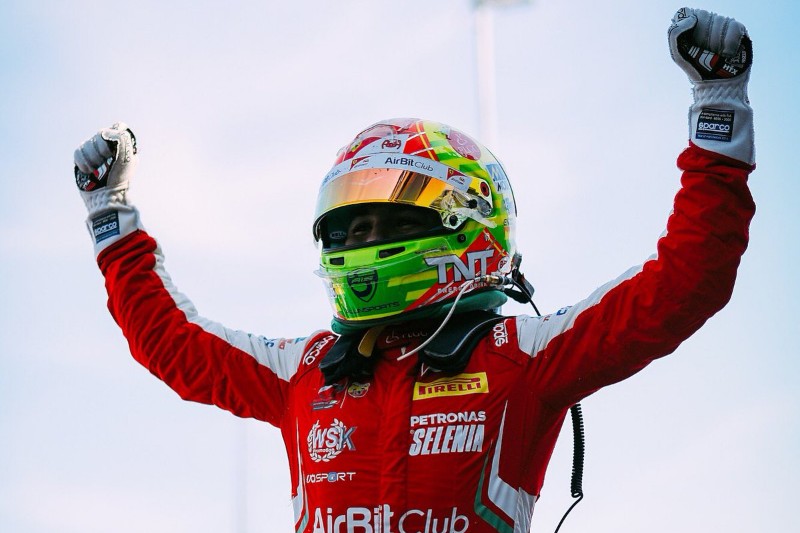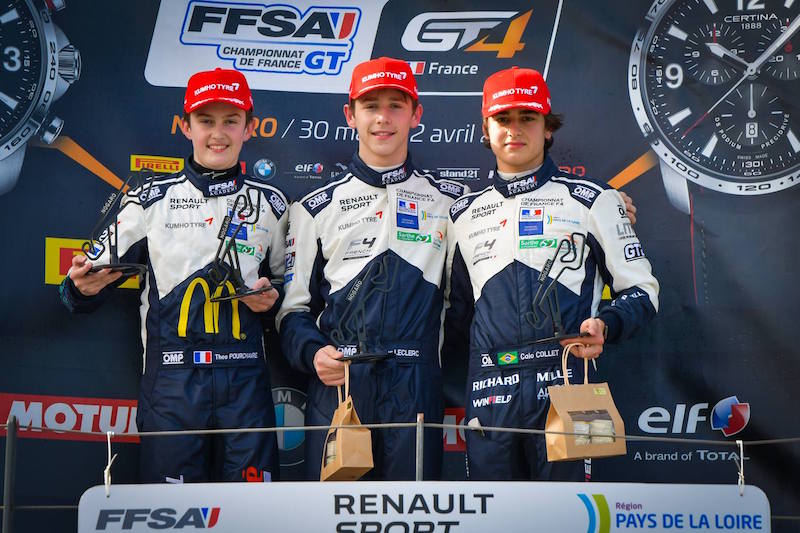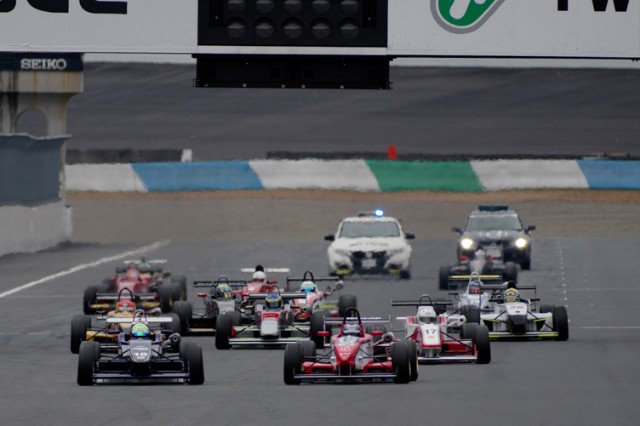
Photo: ADAC/Hoch Zwei
Formula 4 continued its worldwide expansion last year, with FIA rules taking over the French championship, and racing returning to Finland and South America under the ‘Formula Academy’ name. United States F4 also got its own support series in the form of Formula Pro USA, which may continue to grow seeing as US F4 attracted 52 drivers in total this year.
Eight drivers raced with Formula 1 or major manufacturer support, with at least two drivers being added to an F1 team roster for 2019. The highest profile championships were the German and Italian series, which share the same chassis, engine and tyre combination, and many of the same teams.
Having already reviewed the British championsip, which was won by Ferrari Driver Academy target and McLaren Autosport BRDC Award finalist Kiern Jewiss, and given coverage to many of the other F4 championships in 2018, the other series included in this review are ones which rarely get mentioned, despite being training grounds for some top talents.
Germany
Third time proved the trick for US Racing’s Lirim Zendeli, who dominated ADAC F4 in a fashion never seen in the series before.
From qualifying at the opening round, Zendeli set himself up to be the man to beat. He converted two pole positions into two victories but, though no fault of his own, retired from race three. Enzo Fittipaldi took second in that race behind Prema team-mate Olli Caldwell, putting him just five points behind Zendeli. It was the closest anyone would get.
VAR’s Liam Lawson and Fittipaldi acted as Zendeli’s ‘title rivals’, with the pair swapping second place in the championship throughout the year. Neither had the consistency of Zendeli, but were able to stay within touching distance in the first two thirds of the season.
Lawson mounted a promising charge at the Lausitzring, where he managed to halve Zendeli?s lead. The Kiwi’s first win was gifted to him in the chaotic opener, in which many drivers were wiped out by fluid on the track. Zendeli himself was caught out by the spill while leading the race, running through the gravel but emerging with his position intact.
The race was red-flagged to allow marshals to clear the track. On the restart, Lawson tried to attack for the lead but was too far back and it seemed he would have to settle for second again. But that would not be the case, as Zendeli slowed to a stop on the penultimate lap.

Photo: ADAC
It was business as usual in race two, where Zendeli took another lights-to-flag victory while Lawson battled up to third after a slow start. He managed to pull side by side with Caldwell on the final lap, pipping the Brit to second by just 0.054s. Lawson put the overtaking experience to good use in race three, where he fought up from seventh on the grid to take his second victory.
Zendeli?s lead opened up again on the championship’s second trip to Hockenheim. After denying the points leader second in front of the Formula 1 crowd in the opening race, Lawson suffered a puncture in the next after making contact with Zendeli’s team-mate David Schumacher. VAR’s Frederik Vesti won the first race, with Zendeli triumphing in the second.
The following round at the Nurburgring was even worse for Lawson, who scored just six points.?This meant Zendeli was able to seal the title early, with eight victories and a 79-point lead heading into the final Hockenheim triple-header.
Even with the title secure, Zendeli didn?t slow. He picked up two more victories in the finale while Lawson and Fittipaldi battled for second. Fittipaldi had retaken the position after Lawson?s miserable Nurburgring weekend, but now it was his turn to struggle, with just a single points finish as Lawson romped to two poles and two podiums.
Outside the lead battle, the fight for top rookie was much tighter. Seven different drivers stood on the top step of the rookie podium, but the title fight was really between Schumacher and Mucke’s Niklas Krutten, who won the final Nurburgring race. The pair swapped victories and podium finishes through the first half of the year, but a string of top five overall finishes and rookie wins gave Schumacher the advantage. He was annoyed to end the year without an outright podium though.
Vesti was best of the rest in the main standings, finishing fourth with two wins. He was followed by F4 United Arab Emirates champion Charles Weerts and Mick Wishofer, both winners at Hockenheim for VAR and US Racing respectively, and Caldwell.

Photo: ADAC/Gruppe C Photography
Italy
The Italian F4 title fight came down to the final race of the season at Mugello, with safety cars, rain, and a Ferrari-backed champion for the second year in a row. Enzo Fittipaldi’s triumph came after a titanic duel with Leonardo Lorandi, whose poor qualifying for the final race meant a lowly result that did not represent his season.
The pair’s battle started six months before at Adria, where Fittipaldi took a maiden pole position and Lorandi qualified seventh. The Brazilian racer controlled two safety car restarts to claim his first victory, while Lorandi battled through the field for second place.
Positions reversed in race two. Lorandi made a strong start from pole but spent the early part of the race with Fittipaldi and Guanluca Petecof on his tail. He stayed calm under pressure and took his second victory.
Race three and the pair went head to head again. Fittipaldi led from start to finish, but a late safety car left him exposed at the flag, where he pipped Lorandi to win by a minuscule margin. The battle was clearly on.
Or that was how it looked. Both were noticeably absent from the top of the podium when the field went abroad to France’s Paul Ricard circuit for the first time in the series? history. Cameoing Van Amersfoort Racing driver Frederik Vesti stole the show with two victories and a second place, with Fittipaldi’s Prema team-mate Caldwell seizing the other race win.
The title rivals? visit to France started in spectacular fashion. Fittipaldi struggled to control his car in the opening race after contact with another driver damaged his rear wing. He didn?t make the first corner, and collected Lorandi. Both managed to limp back to the pits unaided, where they retired. The rest of the weekend didn?t go much better. Lorandi struggled in the wet in race two and dropped away as Fittipaldi salvaged second. It was the opposite story in race three, with Fittipaldi fifth after starting in first. It was enough to keep him atop the standings though.

Lorandi got his season back on track at Monza, with two victories and a fourth place vaulting him into the points lead as Fittipaldi managed a solitary fifth place. He collided with Lorandi’s Bhaitech team-mate Petr Ptacek in race one, resulting in his second retirement of the season, then did it again on the final lap of the second race.
By now, Caldwell looked like an outside challenger for the title. He had picked up his first win in France and taken a string of podium finishes since. He’d graced the podium just as many times as his two title rivals, but his challenge didn’t last long. Fittipaldi dominated the fourth round at Misano, taking three lights-to-flag victories and moving back into the championship lead. Lorandi struggled in the midfield in the first two races before bringing the fight back to Fittipaldi in race three, and Caldwell did no better than sixth.
Two more wins for Lorandi pushed him back ahead at Imola, with the weekend ending with a first win for Jenzer Motorsport’s Federico Malvestiti on his 61st attempt. Fittipaldi picked up strong points and more podiums, while Caldwell salvaged a second place from an otherwise off weekend.
At Vallelunga, Caldwell bounced back in style though, winning all three races and moving back into the title hunt. In a scene similar to race one in France, Lorandi crashed with Fittipaldi. Lorandi retired after suspension damage sustained from another clash made his car undriveable. Importantly, Fittipaldi was able to stay in the race and finish eighth, and cut into Lorandi’s lead further in the next two races. Just nine points separated the two going into Mugello.

Rain lashed down the whole weekend, and neither Fittipaldi or Lorandi enjoyed the opening race. The pair collided and only Lorandi finished, albeit in 24th. Fittipaldi had taken pole for all three races, and he ensured the same mistake wouldn’t repeat itself in race two. He built a strong lead, but had it cut down at the end and only just won by 0.028s. Two points separated them as they lined up on the grid for the final race. Eight laps later, many of which were under the safety car, Fittipaldi was victorious.
The fight for the top rookie spot was just as hard fought. Petr Ptacek and Prema driver Gianluca Petecof were rarely in the spotlight, though both were often on the podium and Petecof took an overall win in the opening Mugello race. The two dominated the rookie fight and while Petecof was on top in the overall championship order, Ptacek took the glory in the rookie standings.
Seven drivers won a race over the year, with the set being completed by Mucke Motorsport star William Alatalo at Monza.
France
Caio Collet lived up to pre-season expectations to rise above a talented French F4 field in the championship’s first year complying to the FIA’s standards.
Brazilian Collet, a protege of Nicolas Todt’s All Road Management, began his transition from karts by winning races in United Arab Emirates F4 series and claiming the relaunched Volant Winfield at the start of the year, but had to make do with ‘just’ three podiums from the opening round at Nogaro, which served to prove how much opposition he would be up against.
Ugo de Wilde returned for a second year (having only turned 15 the previous November) and quickly got to grips with the new car, winning the first race from pole ahead of Adam Eteki and Collet. Parisian Eteki got the upper hand over de Wilde in the final race of the weekend, with Collet third again.
Arthur Leclerc, Charles’ younger brother whose karting career was restricted largely to a championship-winning campaign in 2014, made a winning start in cars in the reversed-grid race.

Photo: FFSA Academy
The championship’s Pau Grand Prix support slot is often the best proving ground for talent – it’s where Dorian Boccolacci and Sacha Fenestraz enjoyed by far their best weekends during their time in the series. This time it was Collet and Leclerc who came to the fore, the former just holding on to win a superb duel in the first race and triumphing again over de Wilde in race three – enough to hold a narrow points lead over the Belgian. Eteki showed more brilliance with a last-lap pass around the outside to win race two.
At Spa, a wet qualifying session allowed Leclerc and Collet to shine once more, with Leclerc taking pole by three tenths of a second over Collet and more than a second clear of the rest. Neither driver would win a race all weekend however, thanks largely to Spa’s significant slipstream effect. Collet was additionally hampered by a first-race collision, but still increased his championship lead as de Wilde suffered his worst round of the season at home.
De Wilde bounced back with his second win from pole on the championship?s first visit to Dijon since 2007 ? the year Jean-Eric Vergne was champion. By the end of the weekend however, Collet was back on top, coming from fourth on the grid to pass Eteki on the last lap.
This was where Collet kicked into top gear, dominating qualifying and the main races at both Magny-Cours and Jerez to secure the title with a round to spare.

Photo: FFSA Academy
While he was never really a threat in the championship, a second reversed-grid win at Magny-Cours meant Leclerc was on course for the runner-up position going to the final round at Paul Ricard, but a disastrous weekend where he scored just one point meant he cruelly slumped to sixth overall at the end of a promising year.
De Wilde’s title challenge faltered with lacklustre outings at Magny-Cours and Jerez, but he ended the year on a high with a double at Paul Ricard to claim second place.
Not turning 15 until August meant Theo Pourchaire was often missing from the results sheets, but he dominated the junior classification and ultimately came third in the overall classification after an impressively consistent and mature campaign, scoring in all but two races. He won the Spa reversed-grid race outright – at which he point he was right with Collet in terms of points scored.
Eteki took fourth in the overall standings before winning a Porsche Carrera Cup scholarship for 2019. Fifth went to Ulysse de Pauw, who followed in the footsteps of Stoffel Vandoorne by landing a drive in the series in a Belgian federation shootout and took his only win on home ground at Spa.
French junior karting champion Pierre-Louis Chovet ended a tough year – that included one missed round – with a reversed-grid win at Paul Ricard. The returning Stuart White was a winner at Spa, but went no further. Theo Nouet and O’Neill Muth were reversed-grid race winners, the latter doing so ahead of his older brother Esteban at Jerez.
The rest
The closely-related?North European Zone and Spanish F4?championships appeared not as strong as in 2017, when Christian Lundgaard resisted Alexander Smolyar and Bent Viscaal to win both crowns. MP Motorsport remained on top in Spain, with Belgian driver Amaury Cordeel recovering from a first-race disqualification to take the title with a combination of speed and consistency. It was close though: he finished up just four points ahead of Mexican Javier Gonzalez of Drivex, who only turned up in round two. Spaniard Guillem Pujeu, driving for Fernando Alonso’s FA Racing brand, started the year with a hat-trick in Aragon and ended up only another four points behind.
Another MP driver, Isaac Blomqvist, made the early running in the NEZ series together with SMP’s Mikhail Belov, but?Konsta Lappalainen ultimately reclaimed the title for Finland with his family-run team. Belov turned the tables in the new?Formula Academy Finland?series.
JAF Japanese F4 existed long before its FIA-affiliated sibling, and is unique in its F1-style aerodynamics and multiple engine suppliers: Honda, Nissan and Toyota. Previous champions have included Formula 2 drivers Nirei Fukuzumi and Tadasuke Makino. Yuki Tsunoda followed his 2017 triumph by winning the Japanese?FIA F4 championship this year.
Nobuo Kubo replicated his 2013 West title this year, but took until the fourth round of the season at Okayama to win, doing so twice. He skipped the next round at Fuji, but still won the title despite Ota Geejin taking victory – a third of the season, which was followed by a fourth at Suzuka.
The Eastern championship was even more dominant, with champion Kanai Liang Zhong’s first win being taken by 27.669 seconds. He won two more times, while Hirohito Ito went on a winless run to second in the standings. Sportsland SUGO specialist Tatsuya Ota took the first two wins but left one race later.
Geejin won the overall championship, as well as the end of year combined battle round.
Jayden Ojeda dominated the?Australian F4?championship with victories in two-thirds of the 21 races. Cameron Shields had a similar penchant for second place (before missing the last two rounds) and Aaron Love for third place, but it was Ryan Suhle who ended up runner-up with three race wins.

Photo: Formula Four JAP
Frenchman Alessandro Ghiretti took the F4 South East Asia title with a run of wins in the latter half of the campaign, while?Irishman Jordan Dempsey didn’t let his absence from the opening Chinese F4 round stop him from winning that crown.
Dakota Dickerson succeeded Kyle Kirkwood as?champion in the world’s best-subscribed F4 series in the?United States.?Formula Pro USA allows US F4 entrants (and now F3 Americas drivers too) to enter their cars in a second championship based primarily on the western side of the country. The series races at some top tracks, and was an IndyCar support once, and was won this year by PR1 Motorsports’ Scott Huffaker.
Huffaker won 10 of the 12 races, a clean sweep of wins having skipped a round at Sonoma. Kyle Loh took both wins when Huffaker was absent, and finished second in the standings. US F4 champion Dakota Dickerson won the Winter Series.
Canada‘s top single-seater championship, excluding Formula Libre, only had four entries this year, all in Canadian cars. Gamma driver James Morton won the title, and the only to compete in every round, beating P&G driver Richard Walker.
By Bethonie Waring, Elliot Wood and Peter Allen